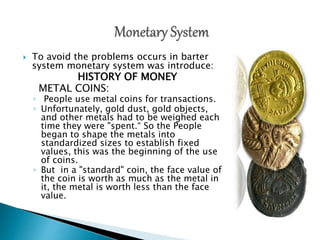Evalution of Money and Banking system
- 1. Presented By: Hammad ali Rida rub Maria Abbasi
- 3. ’üĮ BARTER SYSTEM: ’üĮ People exchange goods and service directly in exchange of goods and service offered by others.
- 4. ’üĮ People have bartered for goods and services since the dawn of civilization, when currencies are unstable or when there is no common currency. ’üĮ Example: A photographer agreeing to photograph a dentist's wedding pictures in return for some dental work of equal value.
- 5. Not speedy transactions Lack of divisibility
- 6. Lack of common measures Valuation of things
- 7. ’üĮ To avoid the problems occurs in barter system monetary system was introduce: HISTORY OF MONEY METAL COINS: ŌŚ” People use metal coins for transactions. ŌŚ” Unfortunately, gold dust, gold objects, and other metals had to be weighed each time they were "spent.ŌĆ£ So the People began to shape the metals into standardized sizes to establish fixed values, this was the beginning of the use of coins. ŌŚ” But in a "standard" coin, the face value of the coin is worth as much as the metal in it, the metal is worth less than the face value.
- 8. ŌŚ” Risk factor is involve i.e. people carry gold and silver coins and there may be a risk of stolen these coins. ŌŚ” Heavy weight is another drawback of metal coins i.e. if people wants to buy a huge thing they should have to carry heavy amount of money. ŌŚ” To avoid these obstacles paper money was introduce.
- 9. ’üĮ The official currency, in the form of banknotes, coins, etc, issued by a government or other authority. ’üĮ It is also called easy medium of exchange.
- 10. Medium of exchange Unit of account Store of value
- 11. Money made up of precious metal or other valuable things
- 12. Piece of paper as a medium of exchange
- 15. ’üĮ Banking starts from goldsmiths. ’üĮ People deposit their gold to the goldsmith then the Goldsmiths would give receipts for the deposits. ’üĮ As more goldsmiths began to issue these paper receipts, it became possible to take a receipt to any smith and cash it in, even if this smith wasn't the smith who originally wrote the receipt.
- 16. ’üĮ The word ŌĆśbankŌĆÖ is derived from the Italian word ŌĆśBancoŌĆÖ which means bench. In the Middle Ages, Italians used to conduct their commercial transactions while sitting on the bench. Later, this very word ŌĆśbancoŌĆÖ underwent changes and became ŌĆśbankŌĆÖ. Now, all the countries of the world have banking systems.
- 17. In England, the first bank was started in the year 1825. The first bank in the U.S.A. was set up in Philadelphia in the year 1782.
- 18. ’üĮ As the time passes this goldsmith system is then converted into modern banking system.
- 19. ’üĮ In the beginnings, Banks had only two functions, namely to receive money and to give loans on interest. ’üĮ Nowadays, Banks serve many other purposes such as giving credit cards and foreign currency to people going abroad. Banks also provide us the facility of lockers to keep our valuable jewelry.
- 20. Debit & Credit Cards Online Banking Mobile & Tablet Banking
- 22. ’üĮ Following are the types of banking: 1. Saving bank 2. Commercial bank 3. Industrial bank 4. Consumer bank, etc























